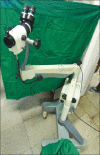An overview of prevention and early detection of cervical cancers
- PMID: 22557777
- PMCID: PMC3342717
- DOI: 10.4103/0971-5851.92808
An overview of prevention and early detection of cervical cancers
Abstract
Cervical cancer still remains the most common cancer affecting the Indian women. India alone contributes 25.41% and 26.48% of the global burden of cervical cancer cases and mortality, respectively. Ironically, unlike most other cancers, cervical cancer can be prevented through screening by identifying and treating the precancerous lesions, any time during the course of its long natural history, thus preventing the potential progression to cervical carcinoma. Several screening methods, both traditional and newer technologies, are available to screen women for cervical precancers and cancers. No screening test is perfect and hence the choice of screening test will depend on the setting where it is to be used. Similarly, various methods are available for treatment of cervical precancers and the selection will depend on the cost, morbidity, requirement of reliable biopsy specimens, resources available, etc. The recommendations of screening for cervical cancer in the Indian scenario are discussed.
Keywords: Cervix cancer; colposcopy; early detection; precancer; prevention; screening; visual examination.
Conflict of interest statement
Figures
Similar articles
-
Cervical Cancer Screening: A Review.JAMA. 2023 Aug 8;330(6):547-558. doi: 10.1001/jama.2023.13174. JAMA. 2023. PMID: 37552298 Review.
-
Prevention of Cervix Cancer in India.Oncology. 2016;91 Suppl 1:1-7. doi: 10.1159/000447575. Epub 2016 Jul 28. Oncology. 2016. PMID: 27463969 Review.
-
"Screen and Treat" Approach among VIA Positive Women during Cervical Cancer Screening Program: Experience at Low Resource Setting.Mymensingh Med J. 2021 Oct;30(4):1100-1106. Mymensingh Med J. 2021. PMID: 34605483
-
Clinical Practice Guidelines on the Screening and Treatment of Precancerous Lesions for Cervical Cancer Prevention in Saudi Arabia.Ann Saudi Med. 2016 Sep-Oct;36(5):313-320. doi: 10.5144/0256-4947.2016.313. Ann Saudi Med. 2016. PMID: 27710981 Free PMC article. Review.
-
Anal dysplasia screening: an evidence-based analysis.Ont Health Technol Assess Ser. 2007;7(4):1-43. Epub 2007 Jun 1. Ont Health Technol Assess Ser. 2007. PMID: 23074504 Free PMC article.
Cited by
-
Factors associated with advanced stage at diagnosis of cervical cancer in Addis Ababa, Ethiopia: a population-based study.BMJ Open. 2020 Oct 13;10(10):e040645. doi: 10.1136/bmjopen-2020-040645. BMJ Open. 2020. PMID: 33051237 Free PMC article.
-
Knowledge, attitude, and practice about cervical cancer and its screening among community healthcare workers of Varanasi district, Uttar Pradesh, India.J Family Med Prim Care. 2019 May;8(5):1715-1719. doi: 10.4103/jfmpc.jfmpc_143_19. J Family Med Prim Care. 2019. PMID: 31198742 Free PMC article.
-
Herpes Simplex Virus, Human Papillomavirus, and Cervical Cancer: Overview, Relationship, and Treatment Implications.Cancers (Basel). 2023 Jul 20;15(14):3692. doi: 10.3390/cancers15143692. Cancers (Basel). 2023. PMID: 37509353 Free PMC article. Review.
-
Evaluation of a real-time optoelectronic method in the diagnostics of CIN over four years of observations.PLoS One. 2021 Feb 26;16(2):e0247702. doi: 10.1371/journal.pone.0247702. eCollection 2021. PLoS One. 2021. PMID: 33635909 Free PMC article.
-
Educational Interventions for Cervical Cancer Screening Behavior of Women: A Systematic Review.Asian Pac J Cancer Prev. 2018 Apr 25;19(4):875-884. doi: 10.22034/APJCP.2018.19.4.875. Asian Pac J Cancer Prev. 2018. PMID: 29693331 Free PMC article.
References
-
- Ferlay J, Shin HR, Bray F, Forman D, Mathers C, Parkin DM. Estimates of worldwide burden of cancer in 2008: GLOBOCAN 2008. Int J Cancer. 2010;127:2893–917. - PubMed
-
- Saslow D, Runowicz CD, Solomon D, Moscicki AB, Smith RA, Eyre HJ, et al. American Cancer Society guideline for the early detection of cervical neoplasia and cancer. CA Cancer J Clin. 2002;52(6):342–62. - PubMed
-
- Hoffman MS, Cavanagh D. Gynecologic Oncology Program. H. Lee Moffitt Cancer Center and Research Institute. [Last accessed on 2011 Feb 10]. Available from: http://www.moffitt.org/moffittapps/ccj/v2n6/article3.html .
-
- Dinshaw KA, Rao DN, Ganesh B. Tata Memorial Hospital Cancer Registry Annual Report. Mumbai, India: 1999. p. 52.
-
- Yeole BB, Jussawalla DJ, Sabnis SD, Sunny L. Survival from breast and cervical cancers in Mumbai (Bombay), India. In: Sankaranarayanan R, Black RJ, Parkin DM, editors. Cancer survival in developing countries. IARC, Scientific Publication No. 145. Lyon, France: International Agency for Research in Cancer; 1998. pp. 79–90. - PubMed
LinkOut - more resources
Full Text Sources





